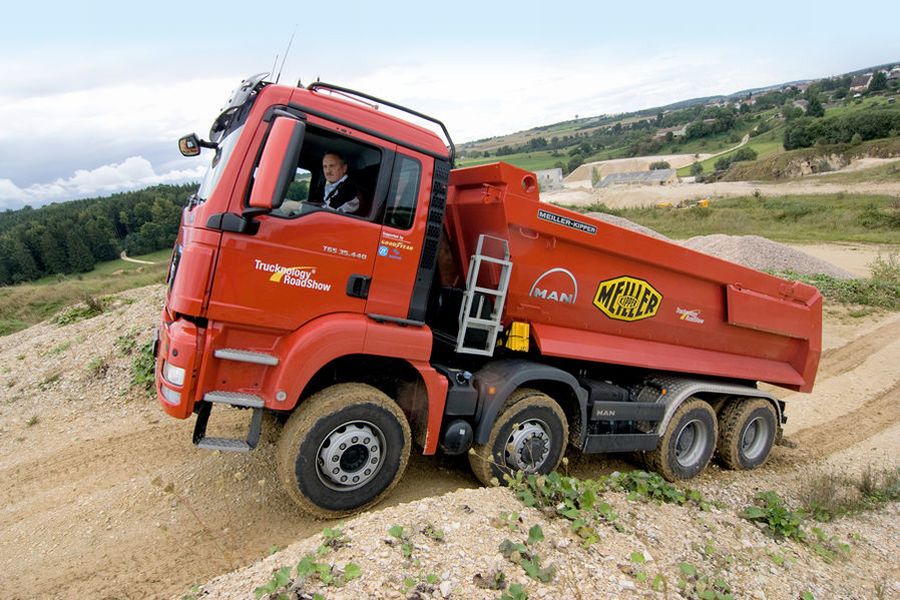
In 2010, lastauto omnibus magazine took the construction truck MAN TGS 35.440 8×6 Hydrodrive on a test-drive. At the time, the focus for the testers was to find out whether a hydrostatic auxiliary drive, instead of conventional four-wheel drive, is a sensible option for a heavy dump truck. The findings at the time: The combination is definitely usable, but with some limitations.
According to lastauto omnibus, the hydrostatic auxiliary drive for the front axle, which MAN calls Hydrodrive, is attractive with its approx. 400 kg lighter weight and a consumption that is comparable to popular 8x4s. By 2010, MAN had already sold more than 5,000 units of this very capable all-terrain power train.
At that time, the product line ranged from a two-axle truck for 18 tons to a four-axle truck with a maximum of 35 tons of technical total weight. The vehicle was considered particularly useful when the truck and the load could not get the traction required. Especially in this case, the front axle provides strong, additional traction and literally pulls the cart out of the quagmire.
Hydrodrive Gets the Truck Moving At Once
The drive system not only provides benefits during empty runs, according to the testers. When the 35.440H four-axle truck drives fully loaded onto a steep section, the wheels will immediately start to spin. Thanks to the hydrodrive, though, the vehicle gets going again at once. The auxiliary front-wheel drive is particularly useful when steep sections have to be climbed in reverse. There are limitations, however. The first front axle tends to lift off when pushing onto the summit of a particularly steep hill and can no longer provide any climbing support. During the test, the MAN was not suited for just any terrain. In sandy terrain, the first, steering axle acts like an additional handicap that must be pushed through the soft ground by the second front axle.
According to the testers, customers who order the 8×6 version of the MAN Hydrodrive should be aware of two things: Although the driver may not have to call a caterpillar for towing in too many cases, the Hydrodrive cannot replace a genuine all-wheel vehicle for extreme missions. In the first place, the hydrostatic front wheel drive throws in the towel at approx. 20 mph (30 km/h), because it tends to overheat at higher speeds. And since the permanent use of the hydraulics also causes overheating, the Hydrodrive is only suitable for occasional use in 8×6 mode.
No automatic gearbox for the MAN Hydrodrive
And there’s one more limitation for the MAN Hydrodrive in 2010. It was not available in combination with an automatic transmission. Instead, the test truck was equipped with a 16-speed manual transmission was. Based on a rear-axle drive ratio of 4.0 and 315/80 R 22.5 tires, this results in a theoretical maximum speed of over 70 mph (112 km/h). For road trips, the resultant rpm in the tallest gear are quite useful: 1450 at 52 mph (85 km/h) and approx. 1100 rpm at 40 mph (65 km/h). , Despite a displacement of only 10.5 liters (610 cubic inches), the small D2066 six-cylinder engine manages very well. The maximum torque range extends up to 1000 rpm, and the little engine is still strong and responsive at 900 rpm. A good match. The power train also adroitly manages to camouflage the fact that slightly lower final speeds in first gear and in reverse gear would not be a bad idea. The first gear reaches 4.2 mph (6.8 km/h) at 1900 rpm, and the first reverse gear reaches 4.5 mph (7.2 km/h).
Praise for Manual Transmission
The testers were full of praise for the manual transmission of the MAN and appreciated the close shift gate and pleasantly short gearshift throws. This compensated for the temperamental gearshift that does not tolerate any imprecision on the driver’s side.
However, the M-type cab of the vehicle did not fully convince the testers in 2010. The motor tunnel is slightly less than 10 inches (26 cm) high and, therefore, not very prominent, but it is topped by the typical MAN cooler with its high hump. This turns climbing through into an acrobatic exercise. The quality of the materials, as well as the fit and finish, of the interior were praised by the critical testers. Cup holders, glasses tray and other trays for oddities around the driver were all deemed flawless. Only the bulky mirrors unnecessarily reduce lateral visibility, according to the testers.
